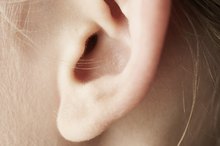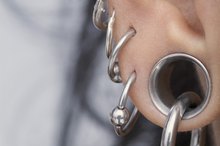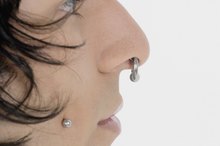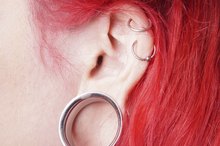How to Treat an infected ear piercing
Infection always is a risk following an ear piercing, even if a sterile procedure is followed. Proper hand washing remains the best prevention against harmful bacteria and infection, but if a pierced ear does become infected, you should treat the wound by following these steps.
If you are experiencing serious medical symptoms, seek emergency treatment immediately.
Remove the earring from the ear at the first sign of infection. Clean the earring and the holes on both sides of the earlobe with sterile gauze and rubbing alcohol (if the ear is not newly pierced). Do this three times a day. If necessary, drain the piercing wound and irrigate with saline solution.
How to Get Rid of Keloids From Industrial Piercings
Learn More
Apply moist heat to the area with warm compresses to promote healing. Dissolve 1/8 tsp. of non-iodized salt in a cup of warm water. Dip a sterile cotton ball into the water, and then hold it gently against the infected pierced ear hole for several minutes. Repeat this procedure twice each day.
Apply a topical antibiotic ointment to the earring post and the piercing hole before reinserting the earring. This will help to fight infectious bacteria, as well as heal the wound faster.
How to Prevent Infection in Pierced Ears
Learn More
Wear earrings made of pure metals such as silver or 24-karat gold. Many people are sensitive to nickel, a metal commonly found in inexpensive earrings. Unfortunately, the allergic reaction can lead to an infection.
Warnings
Antibiotics may be necessary if the infection spreads beyond the immediate site of the ear piercing. If redness and drainage get worse, the ear swells, or you experience pain, have a fever or show no improvement after three days, see your doctor without delay.
Upper ear piercings through cartilage are more likely to get infected than earlobe piercings. Cartilage is more susceptible to infection, as well as more difficult to treat if infection does occur. Because cartilage receives less blood flow, it must depend on surrounding healthy tissue for oxygen.
Related Articles
References
- Gabriel OT, Anthony OO, Paul EA, Ayodele SO. Trends and complications of ear piercing among selected Nigerian population. J Family Med Prim Care. 2017;6(3):517–521. doi:10.4103/2249-4863.222045
- Uter W, Werfel T, White IR, Johansen JD. Contact allergy: A review of current problems from a clinical perspective. Int J Environ Res Public Health. 2018;15(6):1108. doi:10.3390/ijerph15061108
- Park JK, Kim KS, Kim SH, Choi J, Yang JY. Reconstruction of a traumatic cleft earlobe using a combination of the inverted V-shaped excision technique and vertical mattress suture method. Arch Craniofac Surg. 2017;18(4):277-281. doi:10.7181/acfs.2017.18.4.277
Warnings
- Antibiotics may be necessary if the infection spreads beyond the immediate site of the ear piercing. If redness and drainage get worse, the ear swells, or you experience pain, have a fever or show no improvement after three days, see your doctor without delay.
- Upper ear piercings through cartilage are more likely to get infected than earlobe piercings. Cartilage is more susceptible to infection, as well as more difficult to treat if infection does occur. Because cartilage receives less blood flow, it must depend on surrounding healthy tissue for oxygen.
Writer Bio
Amber Keefer has more than 25 years of experience working in the fields of human services and health care administration. Writing professionally since 1997, she has written articles covering business and finance, health, fitness, parenting and senior living issues for both print and online publications. Keefer holds a B.A. from Bloomsburg University of Pennsylvania and an M.B.A. in health care management from Baker College.








